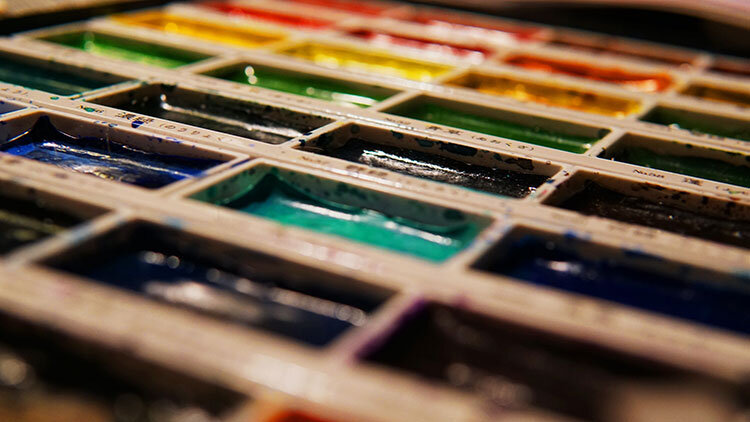
Interview with an Artist in Lockdown
The Zoom call doesn’t connect straight away. A slight lag occurs before Kate Kelly appears on the screen, her smile as bright as the paintings behind her. “Sorry, poor wifi,” she says, her smile growing wider, and grainier, as she gets closer to the computer screen. “We live in the countryside, you can imagine how slow it can be.” Her appearance doesn’t scream artist - The Yayoi Kusama-esqu image I conjured up in my head doesn’t come to fruition. Kelly doesn’t have a red bob but short brown mousey hair. She doesn’t wear a long red polka dot dress, but instead a plain blue jumper, her small round glasses fitting snugly to her face.
Although her face takes up most of the screen, I can still see some of her work behind her - colourful seascapes painted through an impressionistic lens, a homage to Klimt. The canvases, in all shapes and sizes, are scattered around the room creating a mirage of colour behind her. “Colour isn’t usually expected in oil paintings,” Kelly says leaning out of the frame so I could get a better view.
The majority of her paintings are oil on canvas, “I do love the ‘give’ in the canvas when painting, whether swiping a palette knife or dabbing an oil pastel,” she says. “And oils enable a texture to be applied like nothing else. Perfect for studio work.”
Kelly, aged 53, grew up in Cheshire, with her adoptive parents and adopted brother, Robert. She enjoyed the time she spent there - her extended family were only a stone’s throw away in Manchester. But when she found herself yearning for more excitement and drama, as well as wanting to expand her artistic ability and find new ways of painting, she moved across the UK, searching for somewhere that would satisfy her artistic need.
As a child, her family encouraged her pursuit of the arts. “My mum always said that from an early age I had a pen or pencil in hand, and I would constantly be drawing,” she says smiling fondly. “I distinctly remember getting my first little watercolour set, a small black metal box with hard stubs of colour and its own brush and mixing palette in the lid - it was perfect and made me feel like a proper artist.”
Her love for the arts was accelerated at school, and approval from her peers and teachers encouraged Kelly to work even harder. It was the thrill of seeing her work presented on her school wall that encouraged her to apply to Liverpool University’s BA textile and fashion course in 1987.
“It’s a circular thing - finding something you can do and then being praised for it really makes you want to spend more time doing the thing,” she says. Liverpool satisfied Kelly’s need for excitement, its large industrial sites and historic architecture providing ample amounts of inspiration for new pieces of work.
In her third year, she created a 3D, oversized papier-mâché teapot, painted in the theme of Alice in Wonderland, that was displayed in a local gallery. “I love exhibiting my work, it looks so much ‘more’ in the right space. White walls, well lit, with a dedicated space, really sets up the work to shine, shout or shimmer,” she says. “I spend quite a bit of time judging which pieces should sit next to each other.” She looks behind her at her own works before turning back to the screen, “I think it makes a real difference to the story - they must complement their neighbours well.”
2010 was a turning point for Kelly: a move to Pembrokeshire allowed her to explore seas and landscapes. “I love walking the coastal paths and watching the seas and skies in all weathers and lights,” she says. “The paintings are me discovering my new home, my emotional response to this place.”
Her works, with titles such as ‘Pembrokeshire Passion’ or ‘Sugar Gold Sunset (Newgale)’, are inspired by places where Kelly spends a lot of time. “The location, weather, time of day will have associated memories and personal significance,” she explains. Her artworks all have their own individual themes, whether it be a piece celebrating the weather or highlighting the time of day.
Interestingly Kelly doesn’t see herself as a full-time artist, having spent four years working in a local primary school as an emotional literacy-support assistant. This move allowed her to be surrounded by art, as well as caring for her young son, Sam. Even though she has now left this job, she still considers being a mother to be her main role, as well as caring for all of her farm animals - a collection of chickens, pigs and sheep.
As the call draws to a close - Kelly has to pick up her son from school - we turn to the importance of art. “To be creative provides a playful, experimental part of my life,” she says. “Art on the wall is a statement: whether it is an aspiration, emotional connection, celebration, memory, propaganda or pure joy.”